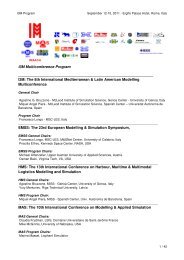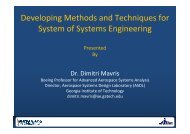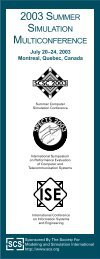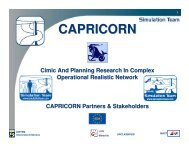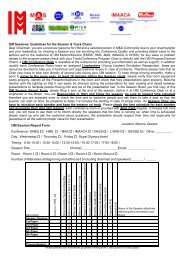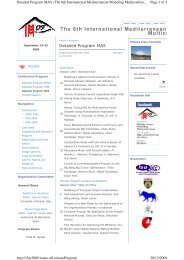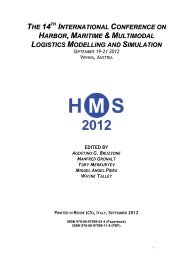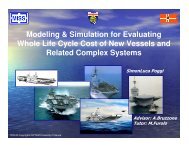HMS2006_F1 - Liophant Simulation
HMS2006_F1 - Liophant Simulation
HMS2006_F1 - Liophant Simulation
Create successful ePaper yourself
Turn your PDF publications into a flip-book with our unique Google optimized e-Paper software.
Once the model had been programmed and<br />
carefully verified, a first set of experiments was<br />
conducted, where the model represented the<br />
current configuration of the system. More<br />
specifically, five replications were done, with a<br />
replication length of a week. The initial state of<br />
the model was obtained from de actual data of<br />
the system, provided by its managers.<br />
The results from these experiments were<br />
compared with the data gathered from the dry<br />
port managers and contrasted with them. The<br />
model proved to be a valid for the purpose of<br />
the study.<br />
5. Computational results<br />
Current situation<br />
According the analysis of the current situation,<br />
the main conclusions that can be drawn from<br />
the study are the following ones:<br />
− Those resources involved in moving freight<br />
are idle for roughly 40% of the time.<br />
− The system can handle a greater number of<br />
trains, but this is not occurring due to the<br />
number of scheduled trains.<br />
− The quality service is not too high, since the<br />
containers’ average time in the system is<br />
3.7 days. The explanation of such a high<br />
figure is, again, the number of scheduled<br />
trains and the fact that this dry port serves<br />
as temporary storage facility for the<br />
maritime ports it is connected to, since the<br />
lack of storage capacity in those ports.<br />
According to these results, a significant<br />
improvement in the dry port performance could<br />
be attained if the institution in charge of setting<br />
the number of trains and their schedules (which<br />
is RENFE) increased the allocation of this sort<br />
of resources to the system.<br />
Scenario 1<br />
Consistently with the growth expectancy for the<br />
following year, a future scenario was<br />
considered. This first scenario differed from the<br />
current situation in the demand, a 30% greater<br />
than the current one. This leap is reasonable,<br />
since the dry port started its operation in 2000<br />
and is still in its initial phase.<br />
As an assumption to this scenario, the number<br />
of trains was supposed to grow in the same<br />
amount as the demand.<br />
In this case, according to the simulation, the<br />
system was expected to perform as follows:<br />
− The resources involved in moving freight<br />
are busy at around 80% of the total time.<br />
− With that use percentage the dry port can<br />
perfectly meet the demand, no trains or<br />
trucks are unattended in this scenario,<br />
which means total effectiveness.<br />
− Besides, average waiting times decrease.<br />
For example the total time a container<br />
spends in the system till shipped is 3.3 days.<br />
This result is not surprising, since as the<br />
demand grows and the resources are not<br />
still overloaded, the greater number of<br />
trains yield that reduction.<br />
Scenario 2<br />
The last scenario under study was characterized<br />
by a demand level equal to its maximum<br />
estimated level: 140 trains per week (70 in and<br />
70 out), which represents almost a threefold<br />
increase of current level of resources.<br />
In case that demand grew to that extent it would<br />
no longer be realistic to keep the shift pattern as<br />
it currently is. For the sake of realism, in this<br />
second scenario the dry port is supposed to<br />
work round the clock in three different shifts.<br />
The expected performance of the system in this<br />
case can be summarized as follows:<br />
− The resources involved in moving freight<br />
are busy at around 90% of the total time.<br />
− Besides, waiting times decrease to an<br />
average of 2.5 days, which means a higher<br />
quality service.<br />
− On average, seven trains are unattended,<br />
which in relative terms represents a 10% of<br />
ineffectiveness. This result is not<br />
inconsistent with the level of idleness of the<br />
available resources, due to the fact that<br />
trains, though previously scheduled, might<br />
not arrive with a pattern which allows a<br />
balanced utilization of resources.



